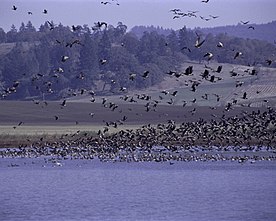
Back حفظ الحياة البرية Arabic Artenschutz German Naturkonservado Esperanto Conservación de la vida silvestre Spanish حفاظت حیات وحش Persian Conservation des espèces French שימור חיות בר HE वन्य जीवन की बातचीत Hindi ವನ್ಯಜೀವಿ ಸಂರಕ್ಷಣೆ Kannada 야생생물보전 Korean

Wildlife conservation refers to the practice of protecting wild species and their habitats in order to maintain healthy wildlife species or populations and to restore, protect or enhance natural ecosystems. Major threats to wildlife include habitat destruction, degradation, fragmentation, overexploitation, poaching, pollution, climate change, and the illegal wildlife trade. The IUCN estimates that 42,100 species of the ones assessed are at risk for extinction.[1] Expanding to all existing species, a 2019 UN report on biodiversity put this estimate even higher at a million species. It is also being acknowledged that an increasing number of ecosystems on Earth containing endangered species are disappearing. To address these issues, there have been both national and international governmental efforts to preserve Earth's wildlife. Prominent conservation agreements include the 1973 Convention on International Trade in Endangered Species of Wild Fauna and Flora (CITES) and the 1992 Convention on Biological Diversity (CBD).[2][3] There are also numerous nongovernmental organizations (NGO's) dedicated to conservation such as the Nature Conservancy, World Wildlife Fund, and Conservation International.
- ^ Cite error: The named reference
IUCN Red List of Threatened Specieswas invoked but never defined (see the help page). - ^ "What is CITES?". CITES: Convention on International Trade in Endangered Species of Wild Fauna dn Flora. Retrieved 2019-05-13.
- ^ "History of the Convention". Convention on Biological Diversity. Retrieved 2019-05-13.
© MMXXIII Rich X Search. We shall prevail. All rights reserved. Rich X Search